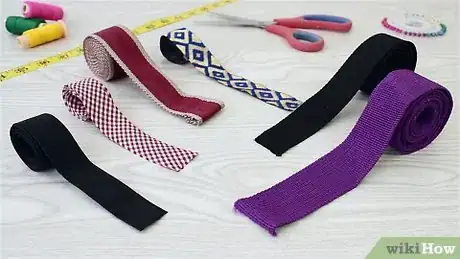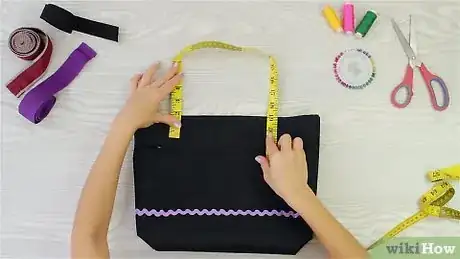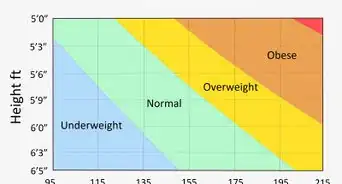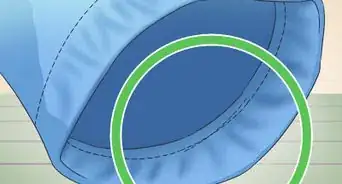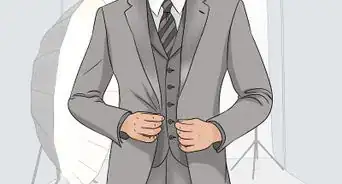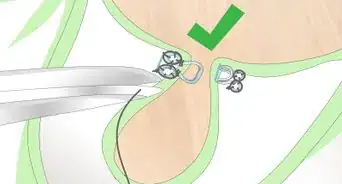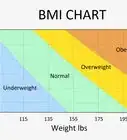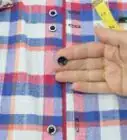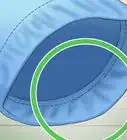This article was co-authored by Korri Burton-Universe. Korri Burton-Universe is a Professional Tailor and the Owner of Uncommon Closet, a custom clothing and tailor resource for the LGBTQIA+ community and those with body types often overlooked by major clothing chains and shops. Korri specializes in custom clothing, tailoring services, and wedding clothes for people of all identities, genders, races, and sizes. Uncommon Closet creates a safe space for people to find or make outfits that make them feel safe and powerful.
This article has been viewed 61,043 times.
Webbing is a strong fabric that is most often used to add a strap to a sewing project. It comes in many different types, fabrics (like nylon!), and colors, so it is quite versatile. Sewing webbing requires some special techniques and materials, but it is easy to do. Try using webbing to add a strap to a messenger bag, purse, or backpack!
Steps
Choosing and Cutting Webbing
-
1Select the type of webbing you want to use. Webbing comes in a wide variety of materials, colors, and widths. Choose the type of webbing that will work best for your.[1]
- You can get webbing in cotton, nylon, polyester, and polypropylene materials. Cotton webbing is good for sewing handles on purses, while a synthetic fabric webbing works well for load bearing projects, such as for backpacks.
- Some types of webbing are 1 solid color, while others have designs printed on them. You can even find webbing with ribbon sewn onto the surface as an accent.
-
2Round up the amount of webbing you need to the nearest yard or half yard. It is important to get more webbing material than you will need to ensure that you do not come up short. Rounding up to the nearest yard or half yard will help to ensure that you have enough.
- For example, if you need 2.75 yards (2.51 m) of webbing, then you may want to purchase 3 yards (2.7 m) of webbing.
Advertisement -
3Determine how wide you want the webbing to be. Most webbing is between 1 to 2.5 inches (2.5 to 6.4 cm) in width, but you may be able to find narrower or wider webbing from craft stores and online retailers. Consider what will work best for your project.[2]
- For example, if you are adding straps to a backpack, you may want webbing that is 2 inches (5.1 cm) wide to provide comfort and stability. Or, if you are making a small purse, then 1 in (2.5 cm) webbing may look best.
-
4Tape the ends of the webbing before you cut them. Webbing unravels easily, so place a piece of tape around the ends of the webbing before you trim it to the size you need for your project. Wrap the tape around the area where you plan to cut the webbing and cut along or through the tape.[3]
- Do not cut down the long edges of webbing to adjust the width. Only cut across the short edges to adjust the length of a piece of webbing.
-
5Melt the ends of the webbing after cutting them, if desired. Melting the ends of webbing can help to prevent it from unraveling. This is a good option if you do not want to leave the tape in place after sewing the webbing. Hold the ends of the webbing over an open flame, such as a lighter, for a few seconds to melt the fibers and secure the ends.[4]
- If you decide to melt the ends of the webbing, make sure that you avoid sewing through this area. It may break or damage your sewing machine needle.
Sewing Machine Set Up
-
1Select a standard or heavy duty thread. You can use a high-quality all-purpose thread to sew most types of webbing. However, if the webbing is extra thick or dense, you may want to use a heavy-duty thread.[5]
- Make sure that the thread color matches your webbing as well. For example, if the webbing is gray, then opt for a gray thread.
-
2Change your sewing machine needle to a heavy-duty universal needle. It is a good idea to install a new sewing machine needle before sewing webbing to ensure that the needle is sharp enough to penetrate the thick fabric. A heavy-duty universal needle works best for sewing webbing. Follow your sewing machine’s instructions for how to install a new needle.[6]
- A size 90/14 or 100/16 needle works well for heavy fabrics, while a 110/18 or 120/19 works well for extra heavy fabrics.[7]
-
3Set your sewing machine to the zigzag stitch. The zigzag stitch will create a strong bond between the fabric and webbing. Adjust the dial or digital display on your sewing machine to set it to the zigzag stitch.[8]
- Consult your sewing machine’s manual for how to set your sewing machine to the zigzag stitch.
- You may use a different type of stitch, if desired, such as the straight stitch. The zigzag stitch is ideal because it will create a secure edge that covers a larger area.
Sewing the Webbing
-
1Pin the ends of the webbing to the fabric or to each other. Before you sew, pin the ends of the webbing to the area of the fabric you want to sew them onto. This will make it a lot easier to sew a tight stich without damaging the clothing. If you are sewing the ends of the webbing together, then insert a pin through the ends of the webbing to connect them where you want to sew.[9]
- Remove the pins just before you sew across them to avoid damaging your machine.
- If you don’t pin the clothing in place, it’ll be hard to stitch in a straight line.
-
2Place the webbing and fabric under the presser foot. Raise the presser foot of your sewing machine by raising the presser foot lever. Slide the end of the webbing and the fabric you want to attach it to under the presser foot. Then, lower the presser foot to secure the fabric in place.[10]
- Check your sewing machine’s manual if you are not sure how to raise and lower the presser foot lever.
-
3Begin sewing across the webbing. Because webbing is a thick material, you may need to turn the wheel on the side of your sewing machine a few times to get it started. Apply gentle pressure to the pedal as you do this and then stop turning the wheel after the machine gets going.[11]
- If the sewing machine has trouble sewing through the webbing and fabric, you may continue to crank the wheel to help it along.
-
4Sew to the edge of the webbing. Go all the way across the piece of webbing to secure it in place. After you finish sewing the webbing to the fabric, remove it from your machine and cut the hanging threads.
- You may even want to backstitch across the webbing after you reach the end to ensure that it is secured. Hold down the lever on the side of your machine while still applying pressure to the pedal. This will reverse the direction of the machine so you can sew back across the area you just stitched.
- Repeat this process to sew the other end of your webbing.
Things You’ll Need
- Webbing
- Scissors
- Tape
- Lighter (optional)
- Sewing machine
- Thread
References
- ↑ https://www.thesprucecrafts.com/webbing-for-straps-and-handles-2978143
- ↑ https://www.thesprucecrafts.com/webbing-for-straps-and-handles-2978143
- ↑ https://www.thesprucecrafts.com/webbing-for-straps-and-handles-2978143
- ↑ https://www.thesprucecrafts.com/webbing-for-straps-and-handles-2978143
- ↑ https://www.thesprucecrafts.com/webbing-for-straps-and-handles-2978143
- ↑ http://specialtyoutdoors.com/tips-for-sewing-your-own-gear/
- ↑ https://www.threadsmagazine.com/2008/11/06/machine-needle-know-how
- ↑ https://www.thesprucecrafts.com/webbing-for-straps-and-handles-2978143
- ↑ https://www.thesprucecrafts.com/webbing-for-straps-and-handles-2978143
